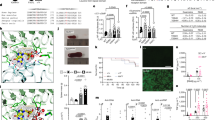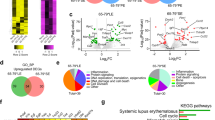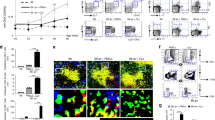Abstract
The NZM2410 Sle2c1 lupus susceptibility locus is responsible for the expansion of the B1a cell compartment, and for the induction of T-cell induced renal and skin pathology on a CD95-deficient (Faslpr) background. We have previously shown that deficiency in the cyclin-dependent kinase inhibitor p18INK4c (p18) was responsible for the B1a cell expansion but was not sufficient to account for the pathology in B6.lpr mice. This study was designed to map the additional Sle2c1 loci responsible for autoimmune pathology when co-expressed with CD95 deficiency. The production, fine-mapping and phenotypic characterization of five recombinant intervals indicated that three interacting subloci were responsive for inducting autoimmune pathogenesis in B6.lpr mice. One of these subloci corresponds most likely to p18 deficiency. Another major locus mapping to a 2-Mb region at the telomeric end of Sle2c1 is necessary to both renal and skin pathology. Finally, a third locus centromeric to p18 enhances the severity of lupus nephritis. These results provide new insights into the genetic interactions leading to systemic lupus erythematosus disease presentation, and represent a major step towards the identification of novel susceptibility genes involved in T-cell-mediated organ damage.
This is a preview of subscription content, access via your institution
Access options
Subscribe to this journal
Receive 6 digital issues and online access to articles
$119.00 per year
only $19.83 per issue
Buy this article
- Purchase on Springer Link
- Instant access to full article PDF
Prices may be subject to local taxes which are calculated during checkout






Similar content being viewed by others
References
Tsokos GC . Systemic lupus erythematosus. N Engl J Med 2011; 365: 2110–2121.
Vaughn SE, Kottyan LC, Munroe ME, Harley JB . Genetic susceptibility to lupus: the biological basis of genetic risk found in B cell signaling pathways. J Leukoc Biol 2012; 92: 577–591.
Morel L . Genetics of SLE: evidence from mouse models. Nat Rev Rheumatol 2010; 6: 348–357.
Morel L, Rudofsky UH, Longmate JA, Schiffenbauer J, Wakeland EK . Polygenic control of susceptibility to murine systemic lupus erythematosus. Immunity 1994; 1: 219–229.
Morel L, Croker BP, Blenman KR, Mohan C, Huang G, Gilkeson G et al. Genetic reconstitution of systemic lupus erythematosus immunopathology with polycongenic murine strains. Proc Natl Acad Sci USA 2000; 97: 6670–6675.
Mohan C, Morel L, Yang P, Wakeland EK . Genetic dissection of systemic lupus erythematosus pathogenesis - Sle2 on murine chromosome 4 leads to B cell hyperactivity. J Immunol 1997; 159: 454–465.
Xu Z, Butfiloski EJ, Sobel ES, Morel L . Mechanisms of peritoneal B-1a cells accumulation induced by murine lupus susceptibility locus Sle2. J Immunol 2004; 173: 6050–6058.
Liu Y, Li L, Kumar KR, Xie C, Lightfoot S, Zhou XJ et al. Lupus susceptibility genes may breach tolerance to DNA by impairing receptor editing of nuclear antigen-reactive B cells. J Immunol 2007; 179: 1340–1352.
Zeumer L, Sang A, Niu H, Morel L . Murine lupus susceptibility locus Sle2 activates DNA-reactive B cells through two sub-loci with distinct phenotypes. Genes Immun 2011; 12: 199–207.
Xu Z, Duan B, Croker BP, Wakeland EK, Morel L . Genetic dissection of the murine lupus susceptibility locus Sle2: contributions to increased peritoneal B-1a cells and lupus nephritis map to different loci. J Immunol 2005; 175: 936–943.
Xu Z, Vallurupalli A, Fuhrman C, Ostrov D, Morel L . An NZB-derived locus suppresses chronic graft versus host disease and autoantibody production through non-lymphoid bone-marrow derived cells. J Immunol 2011; 186: 4130–4139.
Xu Z, Cuda CM, Croker BP, Morel L . The NZM2410-derived lupus susceptibility locus Sle2c1 increases TH17 polarization and induces nephritis in Fas-deficient mice. Arthritis Rheum 2011; 63: 764–774.
Potula HH, Morel L . Genetic variation at an YY-1 response site regulates the transcription of cyclin-dependent kinase inhibitor p18INK4C transcript in lupus-prone mice. J Immunol 2012; 188: 4992–5002.
Potula HH, Xu Z, Zeumer L, Sang A, Croker BP, Morel L . Cyclin-dependent kinase inhibitor Cdkn2c deficiency promotes B1a cell expansion and autoimmunity in a mouse model of lupus. J Immunol 2012; 189: 2931–2940.
Shi X, Xie C, Kreska D, Richardson JA, Mohan C . Genetic dissection of SLE: SLE1 and FAS impact alternate pathways leading to lymphoproliferative autoimmunity. J Exp Med 2002; 196: 281–292.
Watanabe-Fukunaga R, Brannan CI, Copeland NG, Jenkins NA, Nagata S . Lymphoproliferation disorder in mice explained by defects in Fas antigen that mediates apoptosis. Nature 1992; 356: 314–317.
Budd RC, Van Houten N, Clements J, Mixter PF . Parallels in T lymphocyte development between lpr and normal mice. Semin Immunol 1994; 6: 43–48.
Shin MS, Lee N, Kang I . Effector T-cell subsets in systemic lupus erythematosus: update focusing on Th17 cells. Curr Opin Rheumatol 2011; 23: 444–448.
Moulton VR, Tsokos GC . Abnormalities of T cell signaling in systemic lupus erythematosus. Arthritis Res Ther 2011; 13: 207.
Furukawa F, Yoshimasu T . Animal models of spontaneous and drug-induced cutaneous lupus erythematosus. Autoimm Rev 2005; 4: 345–350.
Ghoreishi M, Dutz JP . Murine models of cutaneous involvement in lupus erythematosus. Autoimmun Rev 2009; 8: 484–487.
Yang JQ, Chun T, Liu H, Hong S, Bui H, Van Kaer L et al. CD1d deficiency exacerbates inflammatory dermatitis in MRL-lpr/lpr mice. Eur J Immunol 2004; 34: 1723–1732.
Rose AM, Bell LC . Epistasis and immunity: the role of genetic interactions in autoimmune diseases. Immunol 2012; 137: 131–138.
Boyden LM, Lewis JM, Barbee SD, Bas A, Girardi M, Hayday AC et al. Skint1, the prototype of a newly identified immunoglobulin superfamily gene cluster, positively selects epidermal [gamma][delta] T cells. Nat Genet 2008; 40: 656–662.
Barbee SD, Woodward MJ, Turchinovich G, Mention JJ, Lewis JM, Boyden LM et al. Skint-1 is a highly specific, unique selecting component for epidermal T cells. Proc Natl Acad Sci USA 2011; 108: 3330–3335.
Turchinovich G, Hayday AC . Skint-1 identifies a common molecular mechanism for the development of interferon-gamma-secreting versus interleukin-17-secreting gammadelta T cells. Immunity 2011; 35: 59–68.
Teichmann LL, Schenten D, Medzhitov R, Kashgarian M, Shlomchik MJ . Signals via the adaptor MyD88 in B cells and DCs make distinct and synergistic contributions to immune activation and tissue damage in lupus. Immunity 2013; 38: 528–540.
Mohan C, Alas E, Morel L, Yang P, Wakeland EK . Genetic dissection of SLE pathogenesis - Sle1 on murine chromosome 1 leads to a selective loss of tolerance to H2A/H2B/DNA subnucleosomes. J Clin Invest 1998; 101: 1362–1372.
Guiducci C, Tripodo C, Gong M, Sangaletti S, Colombo MP, Coffman RL et al. Autoimmune skin inflammation is dependent on plasmacytoid dendritic cell activation by nucleic acids via TLR7 and TLR9. J Exp Med 2010; 207: 2931–2942.
Acknowledgements
This work was supported by National Institutes of Health grants K01-AR-056725-01 (ZX) and R01-AI-068965 (LM). We thank the members of the Morel lab for stimulating discussions, Leilani Zeumer for technical help, as well as Nathalie Kanda for outstanding animal care.
Author information
Authors and Affiliations
Corresponding authors
Ethics declarations
Competing interests
The authors declare no conflict of interest.
Rights and permissions
About this article
Cite this article
Xu, Z., Croker, B. & Morel, L. The combination of two Sle2 lupus-susceptibility loci and Cdkn2c deficiency leads to T-cell-mediated pathology in B6.Faslpr mice. Genes Immun 14, 373–379 (2013). https://doi.org/10.1038/gene.2013.28
Received:
Accepted:
Published:
Issue Date:
DOI: https://doi.org/10.1038/gene.2013.28
Keywords
This article is cited by
-
A Skint6 allele potentially contributes to mouse lupus
Genes & Immunity (2017)



